The species are grouped according to when they occur in Dixon:
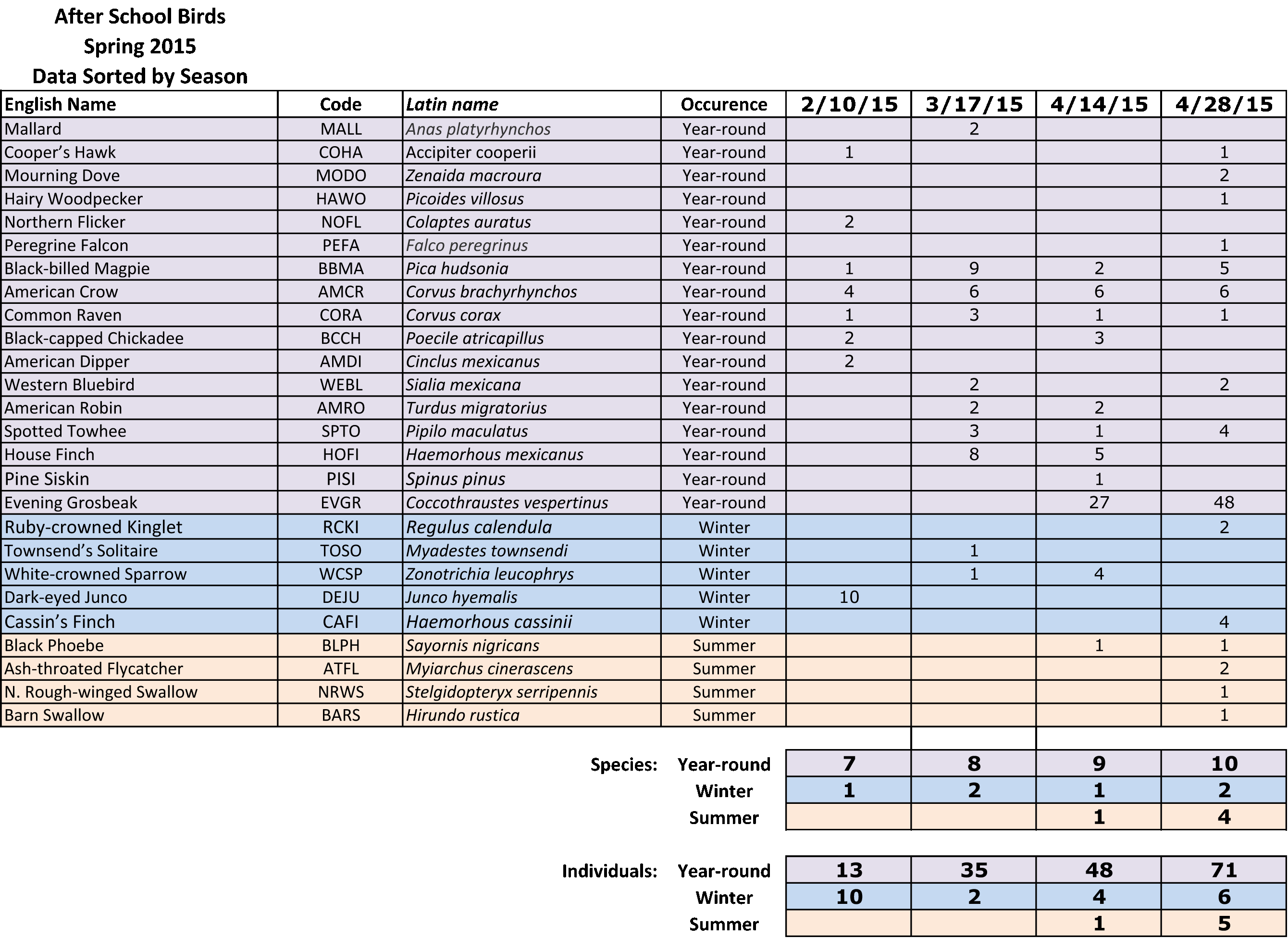
Embudo Valley Library After School Program:
Feb 10, 2015: Picture List Simple, printable list.
Mar 17, 2015: Picture List Simple, printable list.
Feb 10 --> Apr 14, 2015: Simple, printable list.
Listen to Spotted Towhee song and call.
Feb 10 --> Apr 28, 2015: Simple, printable list.
This is a list of all species recorded on the four walks.
The species are grouped according to when they occur in Dixon:
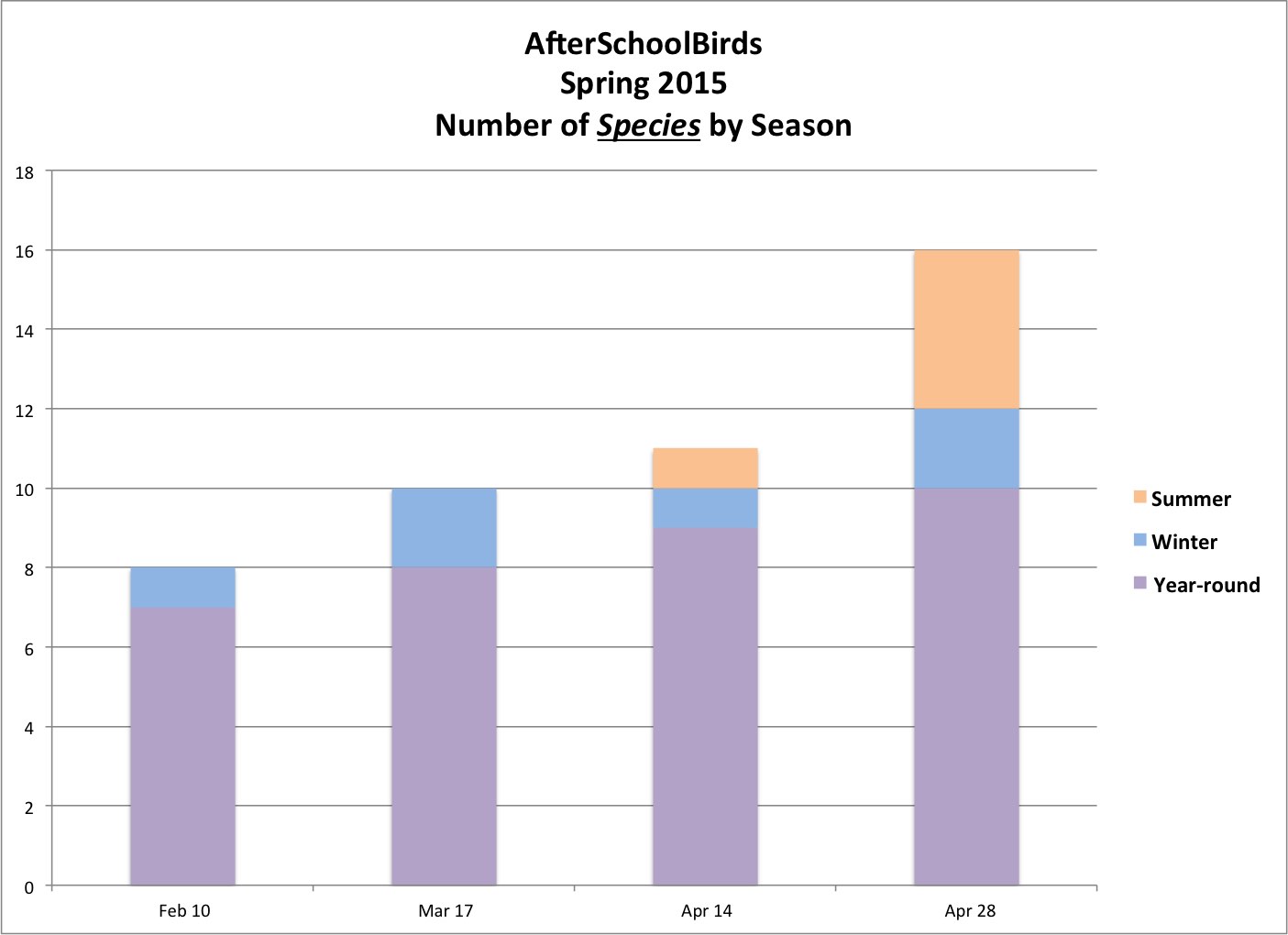
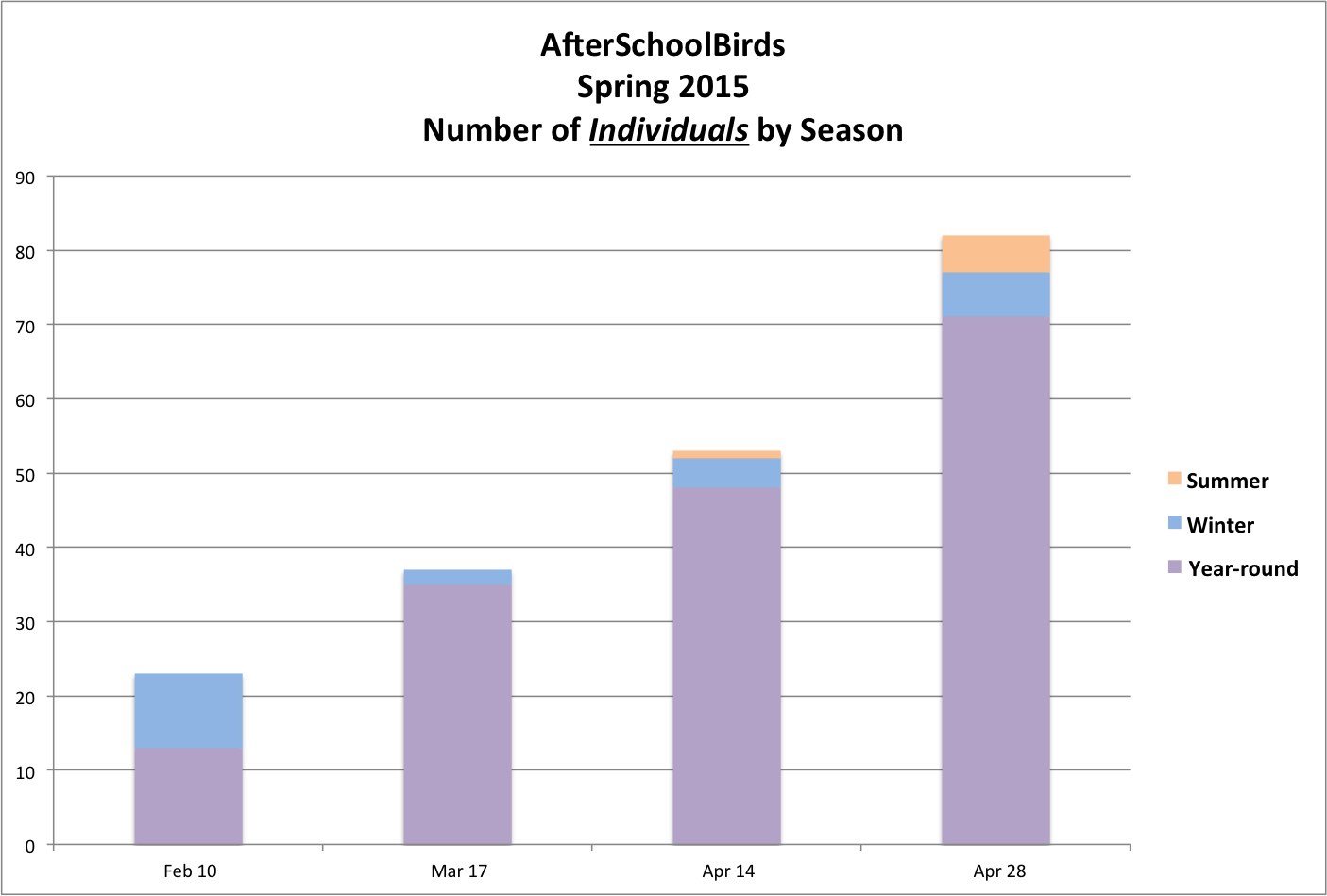
| English Name: Genus specific epithet: | Comments | Photos |
| Swans, Geese and Ducks | ||
| Mallard Anas platyrhynchos 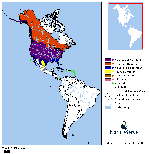 Enlarge Map External Sites: Cornell USGS Image Search | Note white horizontal mark at rear on both Female (above) and Male (below). Male plumage distinctive. Number of Individuals Observed:2 |  Rinconada 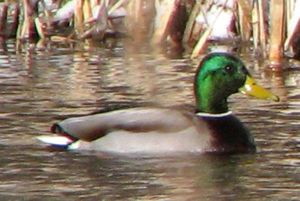 Rinconada  Rio Grande-Taos County Line, June 9, 2014 Enlarge |
| Diurnal Raptors: Vultures, Eagles and Hawks | ||
| Turkey Vulture Cathartes aura 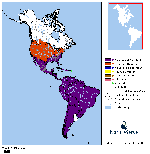 Enlarge Map External Sites: Cornell USGS Image Search | Begins arriving during the last 10 days of March. Majority of residents here by April 1st. | 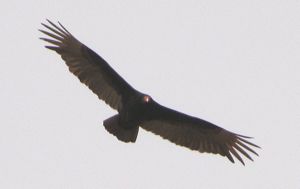 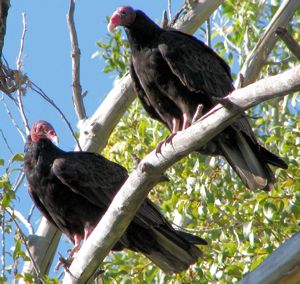 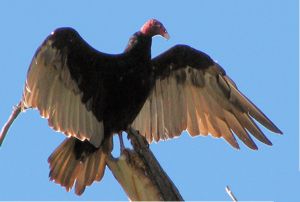 |
| Cooper’s Hawk Accipiter cooperii  Enlarge Map External Sites: Cornell USGS Image Search | Adult is pictured. Note the horizontal barring on the breast and belly. | 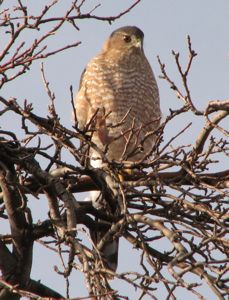 El Bosque |
| Red-tailed Hawk Buteo jamaicensis 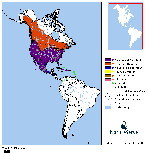 Enlarge Map External Sites: Cornell USGS Image Search | Often easily identified by visible red tail. If tail is not visible, other field marks can be used: From below in flight, the dark front edges of the wings next to the body and the dark "commas" at the wrist are unique among local hawks. When perched, the dark belly band against the white front is diagnostic. Juveniles (lowest photo) do not yet have a red tail. | 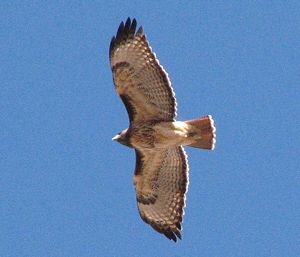 El Bosque 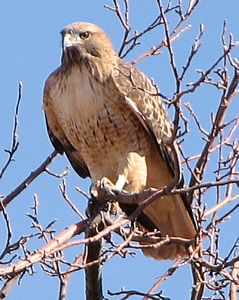 El Bosque 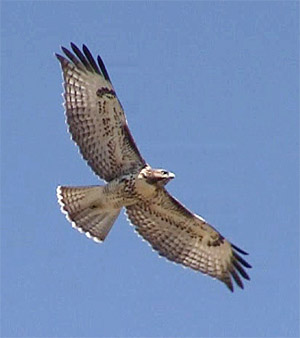 Camino Lejo, Santa Fe |
| Pigeons and Doves | ||
| Rock Pigeon Columba livia 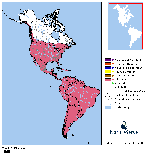 Enlarge Map External Sites: Cornell USGS Image Search | Common on wires around human habitation, this species comes in a variety of colors. Most individuals show two dark wing bars as shown in the upper photo. | 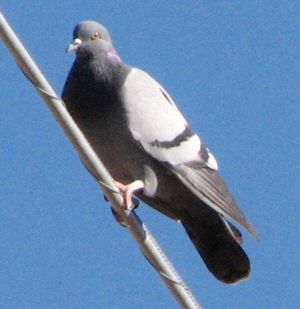 Cañoncito 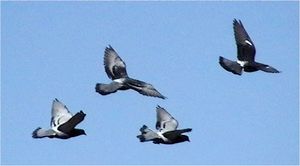 El Bosque |
| Eurasian Collared-Dove Streptopelia decaocto 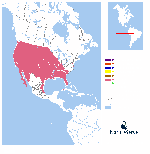 Enlarge Map External Sites: Cornell USGS Image Search | 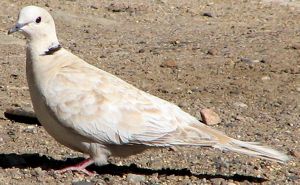 Peñasco | |
| Mourning Dove Zenaida macroura 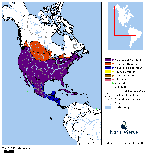 Enlarge Map External Sites: Cornell USGS Image Search | Generally seen flying in small groups (2-4 individuals). Note long, pointed tail which shows white edges when landing. Call is a soft, slow "who-AH, who, who, who" heard during the day. (Commonly mistaken for an owl. Note: Owls usually do not call during daylight hours) | 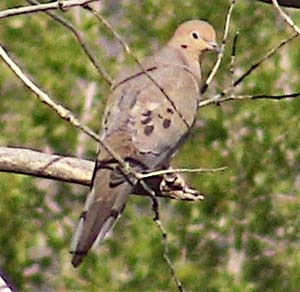 El Bosque 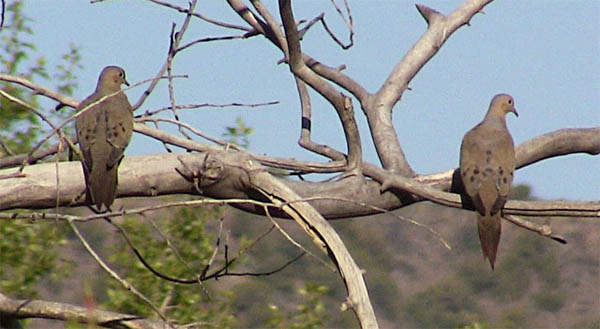 El Bosque |
| Hummingbirds | ||
| Black-chinned Hummingbird Archilochus alexandri 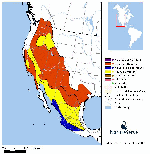 Enlarge Map External Sites: Cornell USGS Image Search | Begins arriving in early April. One of only two hummingbirds that regularly breed here. In the right light, male's throat shows purple below, black above. Often appears more slender and vertical than the Broad-tailed Hummingbird. Male is pictured. Female has plain throat. | 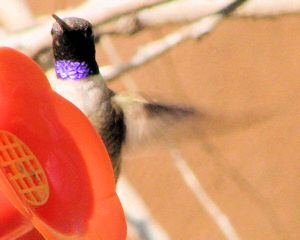 El Bosque 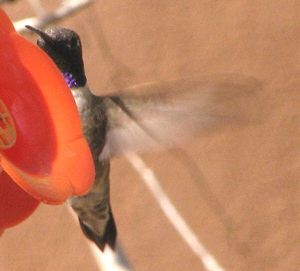 El Bosque |
| Broad-tailed Hummingbird Selasphorus platycercus 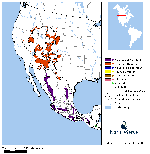 Enlarge Map External Sites: Cornell USGS Image Search | Begins arriving in early April. One of only two hummingbirds that regularly breed here. In the right light, male's throat is red. Often appears plumper and rounder than the Black-chinned Hummingbird. Male's wing make a distinctive, loud buzz in flight. Male is pictured. Female has plain throat. | 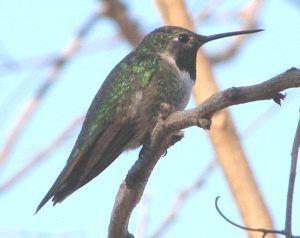 Dixon 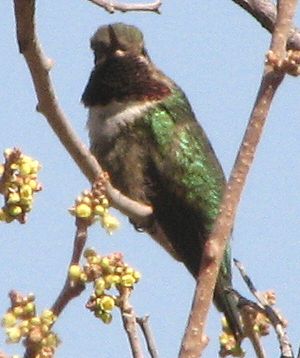 Dixon 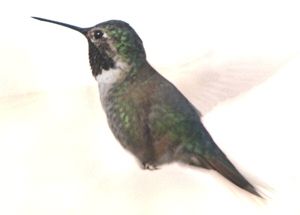 Dixon |
| Woodpeckers | ||
| Downy Woodpecker Picoides pubescens 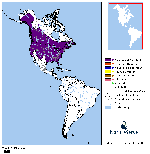 Enlarge Map External Sites: Cornell USGS Image Search | Almost identical to the Hairy Woodpecker in plumage, this smaller woodpecker is generally distinguished by its diminuitive bill which is much shorter than the bird's head from front to back. The red patch on the head indicates that this is a male. | 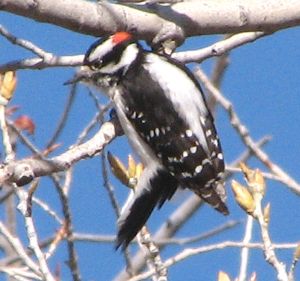 El Bosque |
| Hairy Woodpecker Picoides villosus 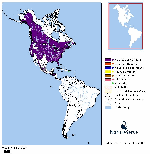 Enlarge Map External Sites: Cornell USGS Image Search | Very similar to Downy Woodpecker, but larger. Commonly distinguished by its large bill which is often as long as the bird's head from front to back. | 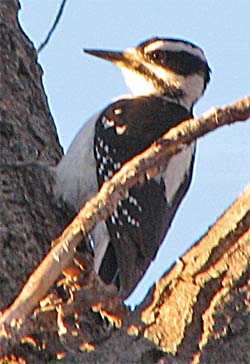 El Bosque 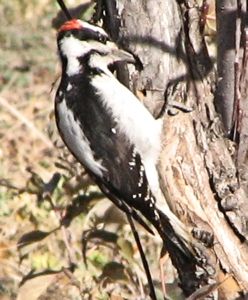 El Bosque |
| Northern Flicker Colaptes auratus 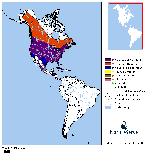 Enlarge Map External Sites: Cornell USGS Image Search | One of the most common birds in the valley. From below, shows red feather shafts in flight. The upper photo shows key marks: Black breast band. Red feather shafts on underside of wings and tail. Red mark under the eye indicates a male. Female (middle photo): no red face mark. Lower photo shows diagnostic white rump patch which is always visible in flight and sometimes visible when perched. | 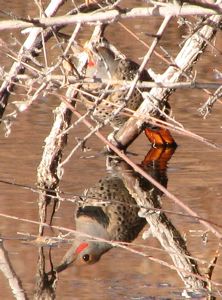 Cachanillas 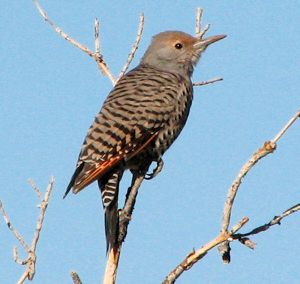 El Bosque 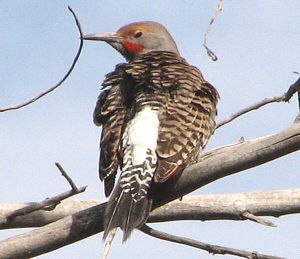 El Bosque |
| Tyrant Flycatchers | ||
| Black Phoebe Sayornis nigricans 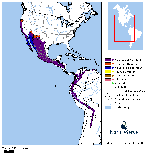 Enlarge Map External Sites: Cornell USGS Image Search | A few individuals over-winter in Velarde. In the rest of the Embudo area begins arriving in early March. Usually seen on low branches overhanging the river, from which it "hawks" insects. At times perches at mid-level in trees near the river, making its sharp, quick two-note call. Distinctive inverted "v" apparent where the white belly meets the dark breast. | 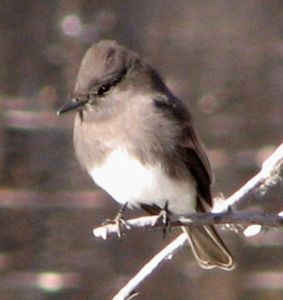 Cachanillas (Velarde) |
| Say's Phoebe Sayornis saya 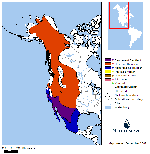 Enlarge Map External Sites: Cornell USGS Image Search | A few individuals over-winter in Velarde. In the rest of the Embudo area begins arriving in early March. Usually seen on posts or single stalk plants in agricutural areas "hawking" insects. It's call is a slow, plaintive, downward slurred "pee-ee". At close range, may hear "pit,pee-ee". Distinctive peach-colored belly. This species regularly builds nests under people's portales. | 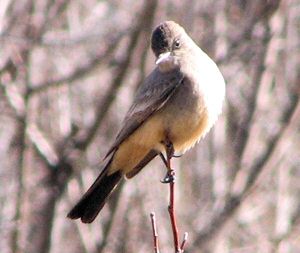 Rinconada |
| Ash-throated Flycatcher Myiarchus cinerascens 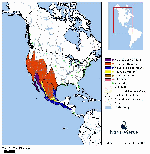 Enlarge Map External Sites: Cornell USGS Image Search | Begins arriving in mid-April. | 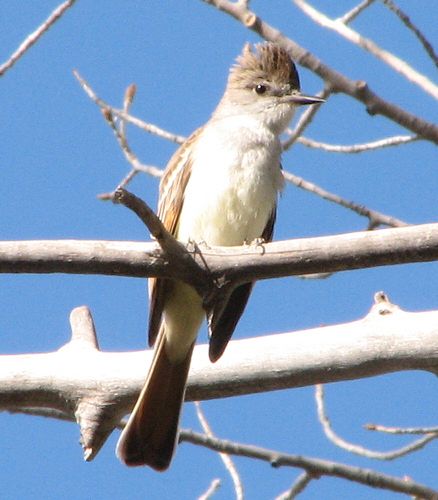 El Bosque 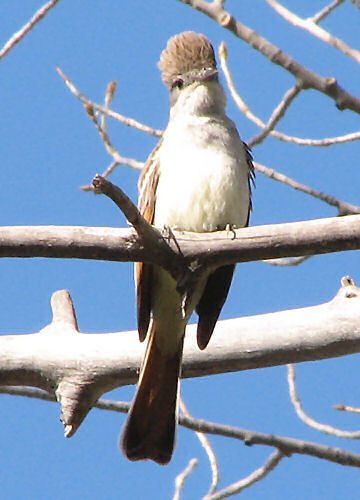 El Bosque |
| Cassin's Kingbird Tyrannus vociferans 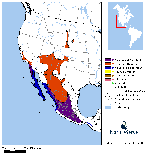 Enlarge Map External Sites: Cornell USGS Image Search | A migrant, this species winters in both mainland Mexico and Baja California. Individuals begin arriving in this area by mid-April. Some pass through to places further north, but many breed here during the summer. They begin moving south to their wintering grounds in early Fall. This species is very noisy making a variety of sounds including its signature, exuberant: "Chi-beer!" | 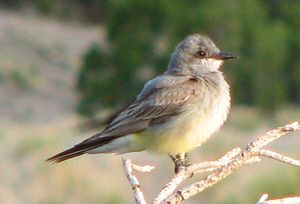 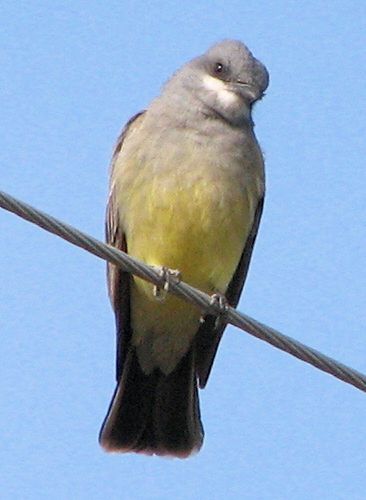 |
| Shrikes and Vireos | ||
| Plumbeous Vireo Vireo plumbeus 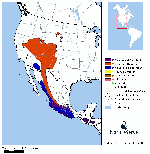 Enlarge Map External Sites: Cornell USGS Image Search | Begins arriving in late April. | 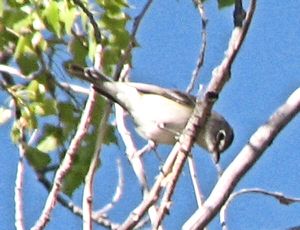 Rio Ojo Sarco 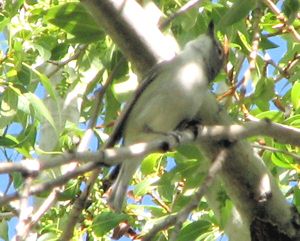 Rio Ojo Sarco |
| Jays, Crows and their Allies | ||
| Pinyon Jay Gymnorhinus cyanocephalus 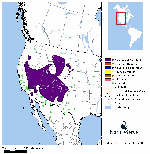 Enlarge Map External Sites: Cornell USGS Image Search | Usually observed while calling in flight. Flocks feed in harvested corn fields or on Piñon-Juniper Hillsides Generally in flocks of 30-70 individuals. Distinguished from Western Scrub-jay by shorter tail and by flocking behavior. | 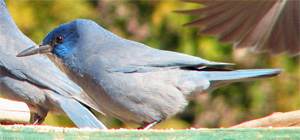 Apodaca 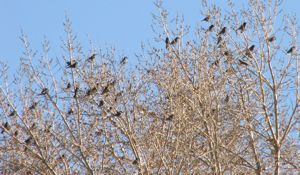 Apodaca 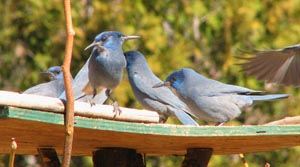 Apodaca |
| Western Scrub-Jay Aphelocoma californica 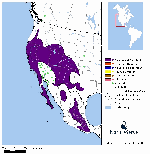 Enlarge Map External Sites: Cornell USGS Image Search | Common in all area habitats. Note white throat and faint white eyebrow. Also brownish-gray back. Distinguished from the Pinyon Jay by longer tail and solitary behavior. | 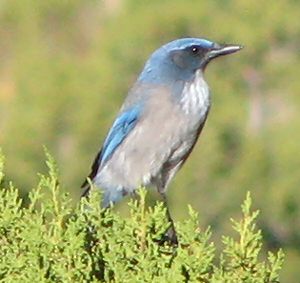 Arroyo la Mina 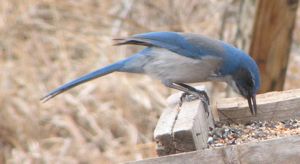 Cañoncito |
| Black-billed Magpie Pica hudsonia 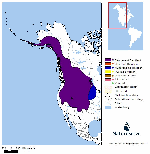 Enlarge Map External Sites: Cornell USGS Image Search | Unmistakable large black and white bird with very long tail. | 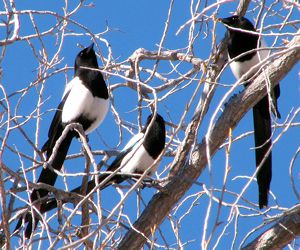 El Bosque |
| American Crow Corvus brachyrhynchos 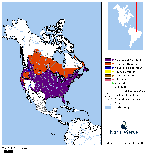 Enlarge Map External Sites: Cornell USGS Image Search | At times difficult to distinguish from Common Raven as the largest Crows are nearly as big as the smallest Ravens. By sound, the crow's "caw" is familiar. In flight, the crow's tail is often square or rounded. Crows are very social and often appear in noisy groups. Bill smaller and thinner than that of the Raven. | 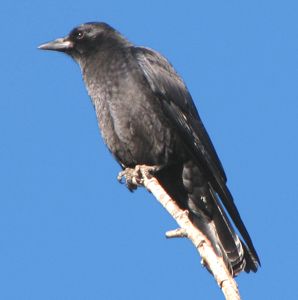 El Bosque |
| Common Raven Corvus corax 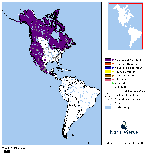 Enlarge Map External Sites: Cornell USGS Image Search | At times difficult to distinguish from American Crow. By sound, a throaty chortle or shout. In flight, the tail often appears wedge shaped. Ravens are often solitary, but sometimes appear with a few other individuals. Often soars like a hawk. Crows do not. Bill is thick and heavy. The throat is shaggy compared to the Crow. Breeding pairs perform synchronized flight high overhead. | 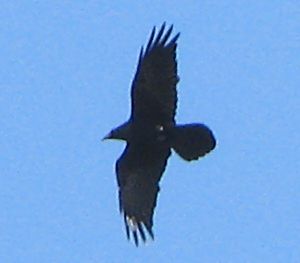 El Bosque 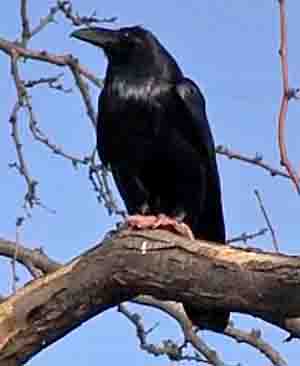 Camino de los Marquez, Santa Fe |
| Swallows | ||
| Violet-green Swallow Tachycineta thalassina 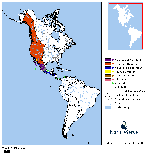 Enlarge Map External Sites: Cornell USGS Image Search | Very common during spring migration. All white below, with white wrapping up the sides of the rump as shown in the upper individual in the lower photo. In right light, the back reveals brilliant violet and green colors. | 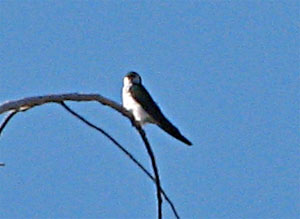 El Bosque 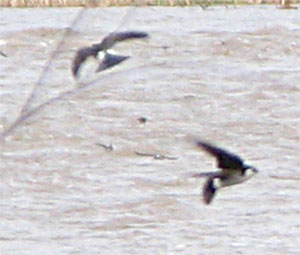 Rinconada |
| N. Rough-winged Swallow Stelgidopteryx serripennis 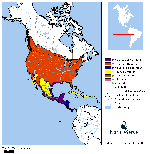 Enlarge Map External Sites: Cornell USGS Image Search | Begins arriving in last half of March. | 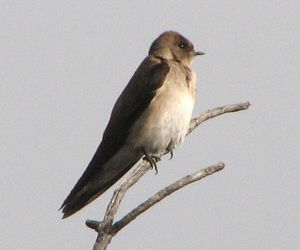 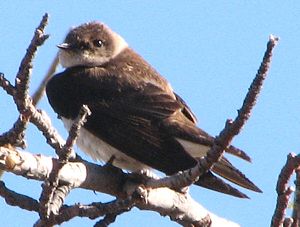 |
| Barn Swallow Hirundo rustica 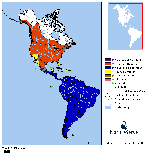 Enlarge Map External Sites: Cornell USGS Image Search | Begins arriving in last half of March. |  Peñasco 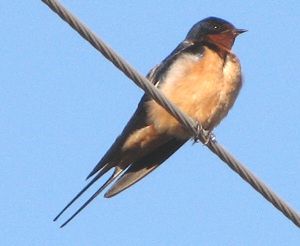 Peñasco 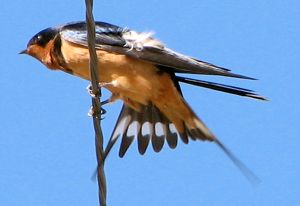 Peñasco |
| Chickadees and their Allies | ||
| Black-capped Chickadee Poecile atricapillus 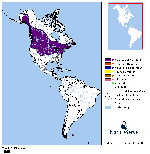 Enlarge Map External Sites: Cornell USGS Image Search | Distinctive Small (~5in) black, white and gray bird that says its name repeatedly: a buzzy chick-a-dee-dee-dee During breeding season, gives a high descending two pitched fee-bee. | 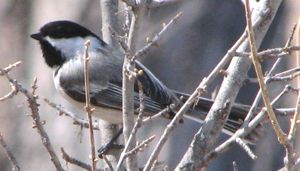 El Bosque |
| Nuthatches and Creepers | ||
| White-breasted Nuthatch Sitta carolinensis 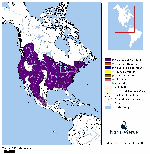 Enlarge Map External Sites: Cornell USGS Image Search | Distinctive black cap starts above the eye. Relatively long, sharp bill. Only local species that walks down tree trunks upside down. Often heard at a distance: Rapidly repeated nasal "huh". Usually 5-8 sounds, all at same pitch. | 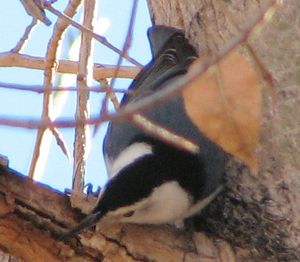 El Bosque 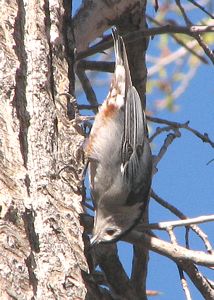 El Bosque |
| Dippers | ||
| American Dipper Cinclus mexicanus 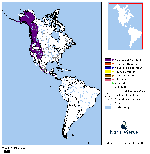 Enlarge Map External Sites: Cornell USGS Image Search | Slate-colored bird seen in rushing streams. Often standing on rocks right at the water level, bobbing by bending its knees. Feeds by walking on the bottom of the stream. |  El Bosque 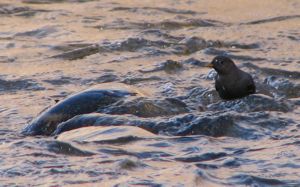 See Slide Show of Dipper Feeding |
| Thrushes and their Allies | ||
| Western Bluebird Sialia mexicana 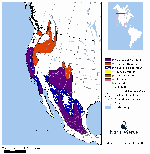 Enlarge Map External Sites: Cornell USGS Image Search | Male (top photo) has blue head and red breast. During breeding season, colors more intense than shown here. Female (middle photo) has blue in wings, but appears gray from front with a light buffy breast. Note white eye-ring. Juvenile on left in lowest photo. Female on right. | 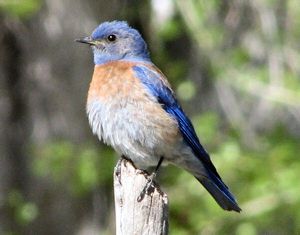 El Bosque 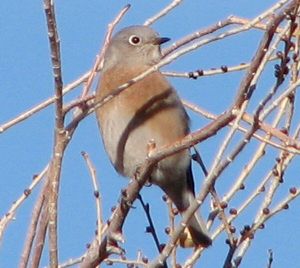 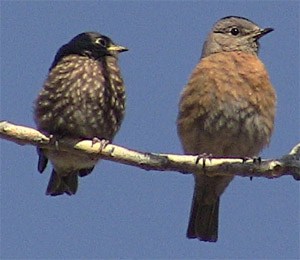 Rinconada Enlarge |
| Mountain Bluebird Sialia currucoides 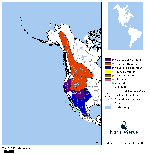 Enlarge Map External Sites: Cornell USGS Image Search | 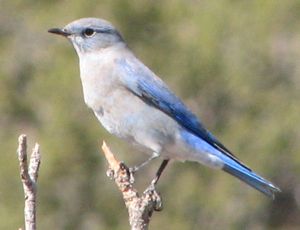 Dixon 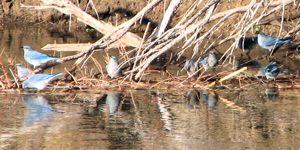 Orilla Verde Enlarge | |
| Townsend’s Solitaire Myadestes townsendi 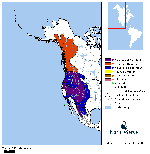 Enlarge Map External Sites: Cornell USGS Image Search | This bird is most often observed sitting in the tops of trees sounding a repeated, high, slow whistle. Gray all over with white on sides of tail. Fluttery in flight, with cream-colored bands running the length of each wing on the underside. | 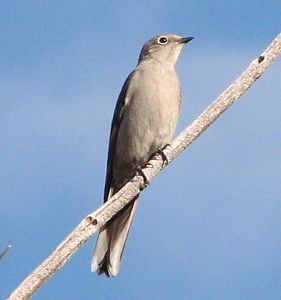 Harding Mine |
| American Robin Turdus migratorius 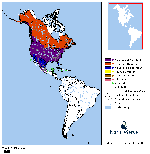 Enlarge Map External Sites: Cornell USGS Image Search | Best known American Bird. Note reddish breast, light colored bill and large white split eye-ring. | 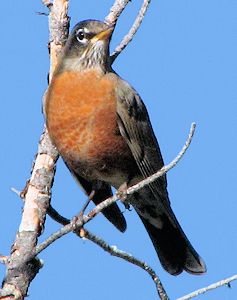 El Bosque |
| Starlings and Mynas | ||
| European Starling Sturnus vulgaris 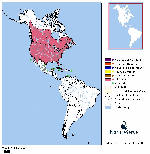 Enlarge Map External Sites: Cornell USGS Image Search | Usually appears black. Often seen flying in large flocks. Flocks move very quickly, changing directions often. Very short tail is distinctive among "blackbirds". Note bright yellow bill. | 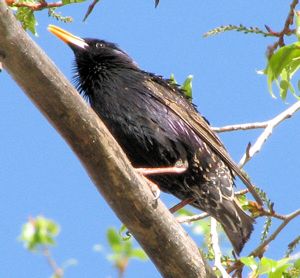 El Bosque Enlarge |
| Wood-Warblers | ||
| Yellow Warbler Dendroica petechia 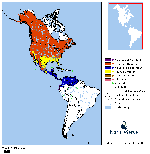 Enlarge Map External Sites: Cornell USGS Image Search | Begins arriving late-April. | 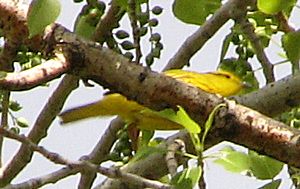 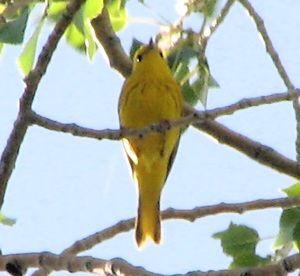 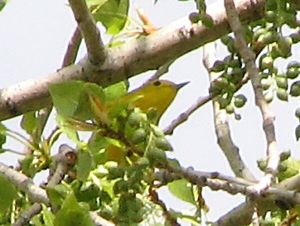 |
| Yellow-rumped Warbler Dendroica coronata 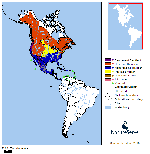 Enlarge Map External Sites: Cornell USGS Image Search | Many individuals pass through this area during the spring and fall migrations. A few stay over the winter, primarily in the Velarde area. The first two pictures show breeding plumage. The last shows typical winter plumage. | 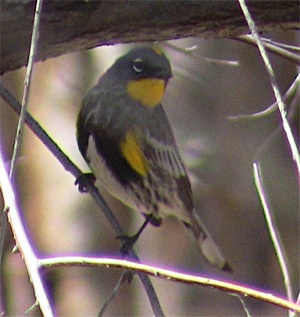 La Junta, April 28, 2013 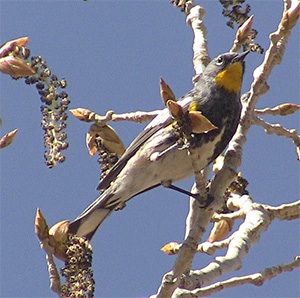 La Junta, April 28, 2013 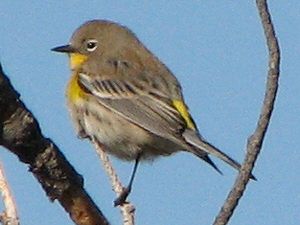 Apodaca |
| Yellow-breasted Chat Icteria virens 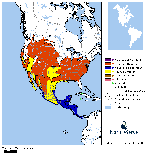 Enlarge Map External Sites: Cornell USGS Image Search | Begins arriving late-April. | 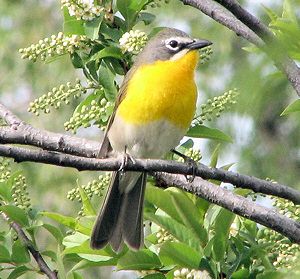 El Bosque 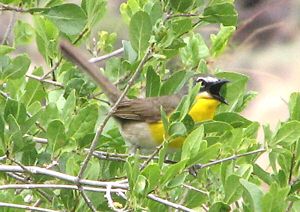 El Bosque |
| Towhees | ||
| Spotted Towhee Pipilo maculatus 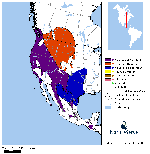 Enlarge Map External Sites: Cornell USGS Image Search | One is seldom far from a Spotted Towhee. But though they are nearby, they are usually hidden away under trees and shrubs where they toss leaves with their feet looking for insects to eat. Occasionally you will see one at the edge of the road or briefly flying from one shrub to the next. However, they regularly produce a contact call, a low growl. Hear Contact Call If you listen for that call and follow it, may be rewarded with a view of this lovely bird with a red eye. Note white breast with rufous (reddish) flanks. Lower Photo shows bird in its preferred habitat. | 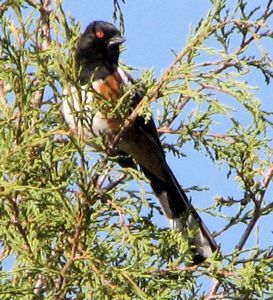 Arroyo la Mina 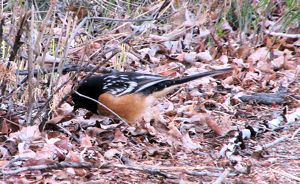 El Bosque Enlarge |
| Sparrows and their Allies | ||
| Chipping Sparrow Spizella passerina 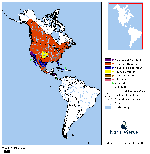 Enlarge Map External Sites: Cornell USGS Image Search | Begins arriving mid-March. | 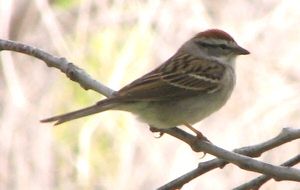 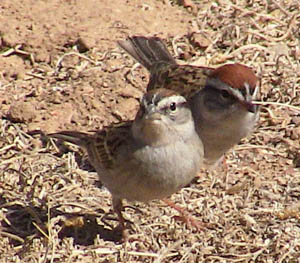 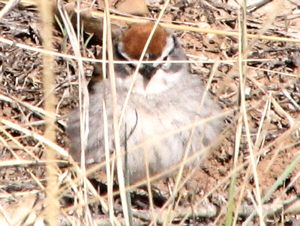 |
| Song Sparrow Melospiza melodia 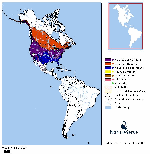 Enlarge Map External Sites: Cornell USGS Image Search | This sparrow is rarely seen more than 50 yards from the river and is often right in the willows at the river's edge. Dark back, with streaks on breasts and sides joining a dark central spot. Has a distinctive flight highlighted by a fairly long, rounded tail. | 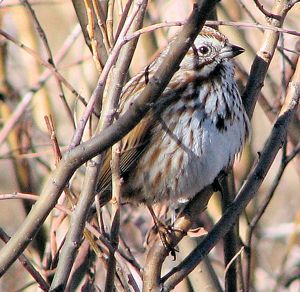 El Bosque |
| White-crowned Sparrow Zonotrichia leucophrys 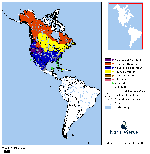 Enlarge Map External Sites: Cornell USGS Image Search | Adult (Upper Photo): Distinctive black and white stripes on head. Light colored bill. Clear breast and belly. Juvenile (Lower Photo): Head stripes brown and gray. | 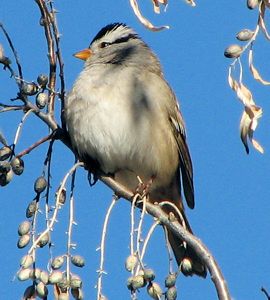 Dixon 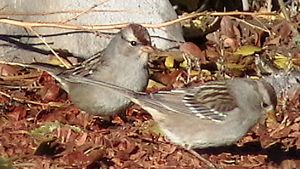 Dixon |
| Dark-eyed Junco Junco hyemalis 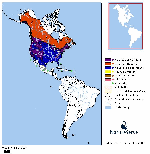 Enlarge Map External Sites: Cornell USGS Image Search | In winter, there are 5 sub-species of Dark-eyed Junco in our area. Many have a full black or gray hood. All have a dark eye set in dark plumage. Almost always in flocks of 10-20 individuals. Identifiable by a very "dry" sounding "tck-tck" and by white showing on the sides of the tail, especially in flight. Do a an Image Search (at left) to get an idea of the great variation in the plumage of this species. | 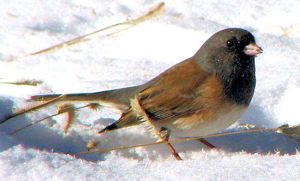 Dixon 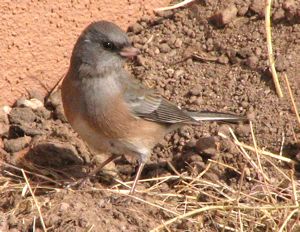 Dixon |
| Tanagers | ||
| Western Tanager Piranga ludoviciana 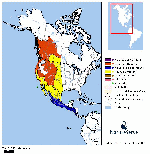 Enlarge Map External Sites: Cornell USGS Image Search | Top Photo: Male Middle Photo: Female Bottom Photo: Male in Flight | 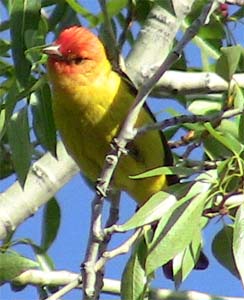 Dixon 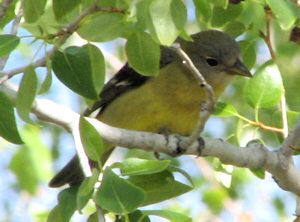 Dixon 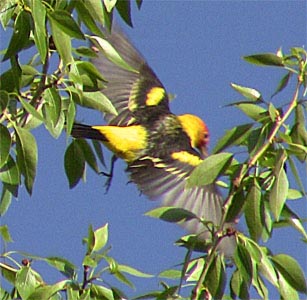 Dixon |
| Grosbeaks | ||
| Black-headed Grosbeak Pheucticus melanocephalus 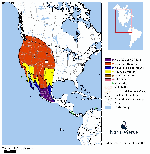 Enlarge Map External Sites: Cornell USGS Image Search | Begins arriving at end of April. | 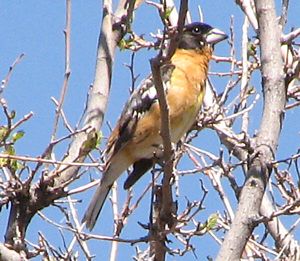 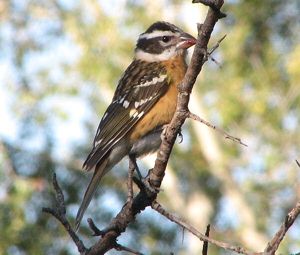 |
| Buntings | ||
| Lazuli Bunting Passerina amoena 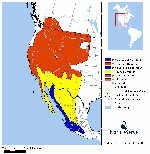 Enlarge Map External Sites: Cornell USGS Image Search | Begins arriving at end of April. | 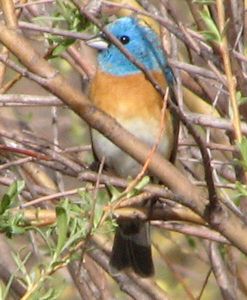 El Bosque 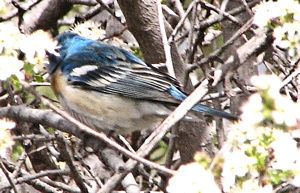 El Bosque |
| Icterids: Blackbirds, Orioles and their Allies | ||
| Bullock's Oriole Icterus bullockii 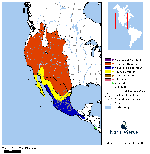 Enlarge Map External Sites: Cornell USGS Image Search | Begins arriving at end of April. | 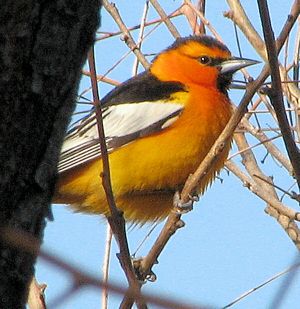 El Bosque 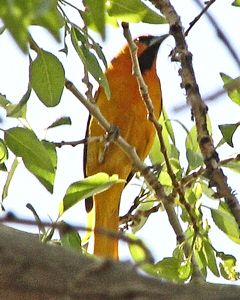 El Bosque |
| Finches and Old World Sparrows | ||
| House Finch Carpodacus mexicanus 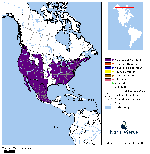 Enlarge Map External Sites: Cornell USGS Image Search | Often seen at feeders, this species is common in all habitats, especially agricultural areas. Male (upper picture) is easily identified by red plumage on head, throat, breast and rump. Female (lower photo) does not have red. Both sexes have streaking on breast, belly and flanks. | 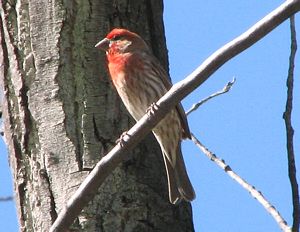 Arroyo La Mina 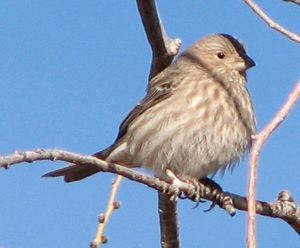 Arroyo La Mina |
| Lesser Goldfinch Carduelis psaltria 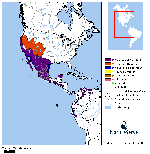 Enlarge Map External Sites: Cornell USGS Image Search | Begins arriving at end of April. | 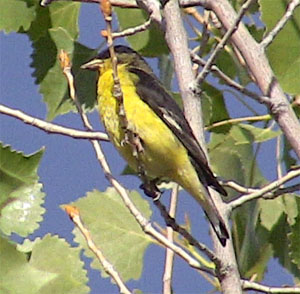 Dixon - June 7, 2014 |
| American Goldfinch Carduelis tristis 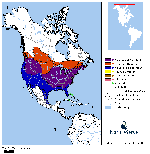 Enlarge Map External Sites: Cornell USGS Image Search | Female (Upper Photo) Male (Lower Photo) | 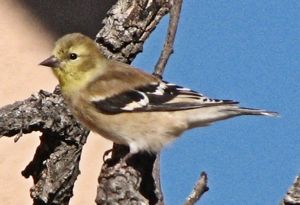 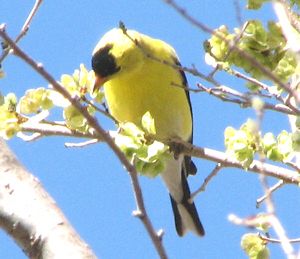 |
| Evening Grosbeak Coccothraustes vespertinus 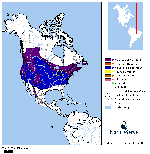 Enlarge Map External Sites: Cornell USGS Image Search | 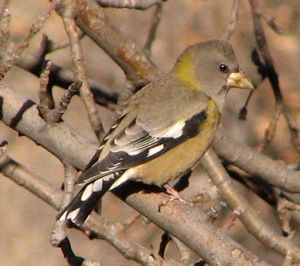 Dixon 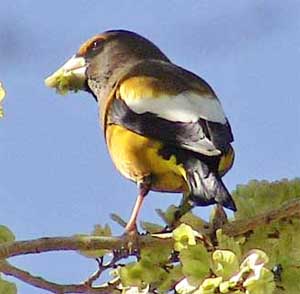 Paseo de Peralta, Santa Fe | |
| House Sparrow Passer domesticus 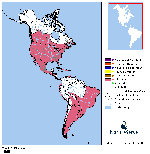 Enlarge Map External Sites: Cornell USGS Image Search | Common across the continental U.S., this species is generally found around human habitation. The female (upper picture) is fairly plain with a weak, white eyebrow. The male (lower picture) has black on the throat, a strong dark mask: often black in front of eye, reddish-brown (rufous) behind the eye. Often in noisy flocks of 5-15 individuals. | 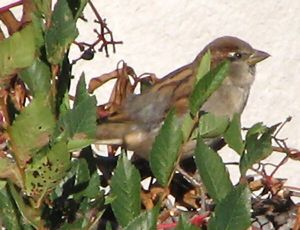 Embudo Valley Library, Dixon 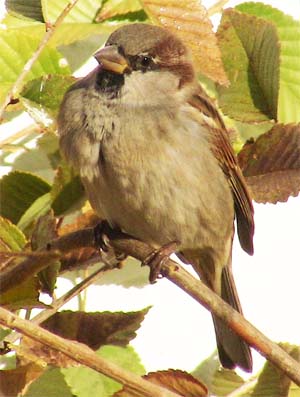 Nob Hill, Albuquerque |